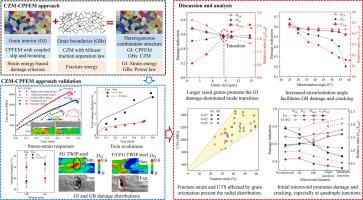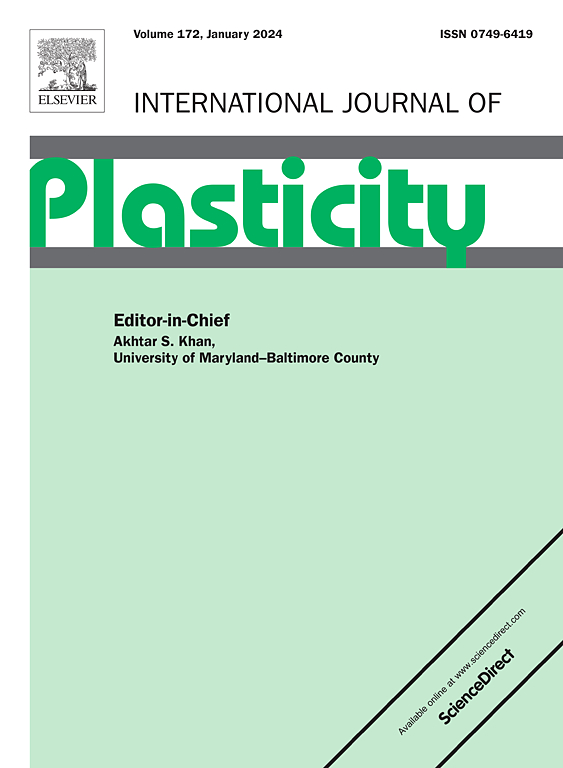In-situ experiment and numerical modelling of the intragranular and intergranular damage and fracture in plastic deformation of ductile alloys
IF 9.4
1区 材料科学
Q1 ENGINEERING, MECHANICAL
引用次数: 0
Abstract
In this research, a unified damage indication considering the intragranular and intergranular damage initiation and evolution was developed for studying the damage and fracture behaviours of the excellent ductile alloys represented by TWIP steels, and a cohesive zone model-crystal plasticity finite element method (CZM-CPFEM) approach was developed, where the crystal plasticity with coupled slip and twinning and the strain energy-based damage criterion was employed to reveal the plastic deformation and damage in grain interior (GI), while the quadratic nominal stress (QUADS) and the power law of the CZM were selected to describe the damage and cracking at the grain boundaries (GBs). The stress-strain responses, twin evolutions, damage nucleation and cracking of fine-grained (FG) and fine-/ultrafine-grained (F/UFG) TWIP steels were validated by in-situ SEM/EBSD tensile experiments. The effects of grain size, misorientation angle, grain orientation and initial microvoids on the GI and GB damage and fracture were studied and analysed by combining micromechanical tests and the CZM-CPFEM approach. The results demonstrated that the interaction of deformation mechanisms promoted the preferential initiation of microcracks at GBs and their junctions, while slip bands and twin bundles in GI induced the rapid growth and extension of the localized microcracks, eventually resulting in the mixed fracture mode of intergranular and intragranular cracks. In addition, GB damage was dominant for F/UFG TWIP steels. Increasing grain size can effectively suppress GB damage and increase the proportion of GI damage. Larger misorientation angles can weaken GB properties, while smaller misorientation angles effectively promote strain/stress coordination and delay GI and GB damage. Larger Schmid factors for slip and twinning are favourable for activating dislocations and twins, promoting strain/stress coordination to retard microcrack initiation and improving uniform elongation. Moreover, both initial microvoids can effectively reduce uniform tensile strength (UTS) and fracture strain. Specifically, the microvoids located at GBs and their junctions increase the percentage of GB damage and the possibility of intergranular cracking, especially at the quadruple junctions of GBs.


韧性合金塑性变形中晶内和晶间损伤与断裂的现场实验和数值模拟
在这项研究中,为研究以 TWIP 钢为代表的优异韧性合金的损伤和断裂行为,开发了一种考虑晶内和晶间损伤起始和演化的统一损伤指示,并开发了一种内聚区模型-晶体塑性有限元法(CZM-CPFEM)方法、其中,采用具有耦合滑移和孪晶的晶体塑性以及基于应变能的损伤准则来揭示晶粒内部(GI)的塑性变形和损伤,同时选择二次名义应力(QUADS)和 CZM 的幂律来描述晶界(GB)的损伤和开裂。原位 SEM/EBSD 拉伸实验验证了细晶粒 (FG) 和细/超细晶粒 (F/UFG) TWIP 钢的应力-应变响应、孪生演变、损伤成核和开裂。结合微机械试验和 CZM-CPFEM 方法,研究和分析了晶粒大小、取向偏差角、晶粒取向和初始微空洞对 GI 和 GB 损伤和断裂的影响。结果表明,变形机制的相互作用促进了 GB 及其交界处微裂纹的优先萌生,而 GI 中的滑移带和孪晶束诱导了局部微裂纹的快速增长和扩展,最终导致晶间裂纹和晶内裂纹的混合断裂模式。此外,GB 损伤在 F/UFG TWIP 钢中占主导地位。增大晶粒尺寸可有效抑制 GB 损伤,增加 GI 损伤的比例。较大的错误取向角会削弱 GB 性能,而较小的错误取向角则能有效促进应变/应力协调,延迟 GI 和 GB 损伤。较大的滑移和孪生 Schmid 因子有利于激活位错和孪生,促进应变/应力协调以延缓微裂纹的产生,并改善均匀伸长率。此外,两种初始微空洞都能有效降低均匀拉伸强度(UTS)和断裂应变。具体来说,位于 GB 及其交界处的微空洞会增加 GB 损坏的百分比和晶间开裂的可能性,尤其是在 GB 的四重交界处。
本文章由计算机程序翻译,如有差异,请以英文原文为准。
求助全文
约1分钟内获得全文
求助全文
来源期刊

International Journal of Plasticity
工程技术-材料科学:综合
CiteScore
15.30
自引率
26.50%
发文量
256
审稿时长
46 days
期刊介绍:
International Journal of Plasticity aims to present original research encompassing all facets of plastic deformation, damage, and fracture behavior in both isotropic and anisotropic solids. This includes exploring the thermodynamics of plasticity and fracture, continuum theory, and macroscopic as well as microscopic phenomena.
Topics of interest span the plastic behavior of single crystals and polycrystalline metals, ceramics, rocks, soils, composites, nanocrystalline and microelectronics materials, shape memory alloys, ferroelectric ceramics, thin films, and polymers. Additionally, the journal covers plasticity aspects of failure and fracture mechanics. Contributions involving significant experimental, numerical, or theoretical advancements that enhance the understanding of the plastic behavior of solids are particularly valued. Papers addressing the modeling of finite nonlinear elastic deformation, bearing similarities to the modeling of plastic deformation, are also welcomed.
 求助内容:
求助内容: 应助结果提醒方式:
应助结果提醒方式:


